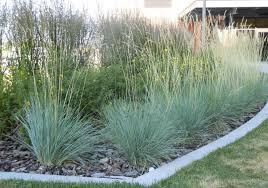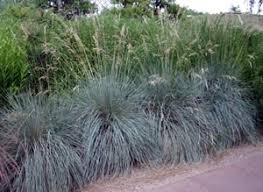Helictotrichon Sempervirens Grass, also known as Blue Oat Grass, is a beautiful and unique plant that can add a touch of elegance to any garden. With its striking blue-gray color and graceful arching form, it’s a popular choice among gardeners and landscapers alike.
Blue Oat Grass is a type of ornamental grass that stays green and vibrant throughout the year, making it a “sempervirens” plant, which means it’s always alive and never goes dormant. This is great news for those who want a low-maintenance plant that maintains its beauty all year long.
One of the most appealing features of Helictotrichon Sempervirens is its color. The blue-gray hue sets it apart from the usual greenery in a garden, creating a calming and cooling effect. Its leaves are narrow and long, and they grow in dense tufts that can reach about 2 to 3 feet in height. When the wind blows, the grass gently sways, adding a sense of movement to your outdoor space.
Blue Oat Grass is quite easy to care for, making it an excellent choice for both beginner and experienced gardeners. It’s drought-tolerant, meaning it can withstand periods of low water availability, making it suitable for areas with dry climates or those who want to conserve water. Plant it in well-draining soil and give it some sunlight, and it will thrive without much fuss.
In the summer, Blue Oat Grass produces tall flower stalks that rise above the foliage, creating a feathery and airy appearance. The flowers start off green and eventually turn a lovely shade of tan as they mature. These flower stalks can persist well into the winter months, adding interest and texture to the garden even when other plants have gone dormant.
To keep your Helictotrichon Sempervirens looking its best, it’s a good idea to trim back the old flower stalks in the spring before new growth begins. This will help maintain the plant’s neat appearance and encourage healthy new growth.
However, Helictotrichon Sempervirens Grass, or Blue Oat Grass, is a versatile and stunning addition to any garden. With its unique color, graceful form, and year-round vibrancy, it’s a low-maintenance option that can elevate the beauty of your outdoor space. Whether you’re a seasoned gardener or just starting out, this ornamental grass is sure to bring joy and visual interest to your landscape.
Read Also: 10 Medicinal Health Benefits of Black Cardamom (Amomum subulatum)
How to Grow and Care for Helictotrichon Sempervirens Grass

Growing and caring for Helictotrichon Sempervirens, or Blue Oat Grass, is relatively easy. Here’s a simple guide to help you successfully cultivate and maintain this beautiful ornamental grass:
1. Choosing the Right Location: Select a spot in your garden that receives full sun to light shade. Blue Oat Grass prefers well-draining soil and can tolerate a range of soil types, as long as they don’t become waterlogged.
2. Planting: Plant Blue Oat Grass in the spring or fall. Dig a hole slightly larger than the root ball and place the plant in the hole at the same depth it was in the nursery container. Fill in the hole with soil and pat it down gently.
3. Watering: During the first growing season, keep the soil consistently moist until the plant establishes its root system. Once established, Blue Oat Grass is drought-tolerant and only needs occasional watering during dry spells.
4. Mulching: Applying a layer of mulch around the base of the plant can help retain moisture and prevent weed growth. Use a light layer of organic mulch, such as wood chips or straw.
5. Pruning: Trim back the old flower stalks in the spring to encourage new growth and maintain the plant’s appearance. You can also remove any dead or damaged leaves as needed throughout the year.
6. Fertilizing: Blue Oat Grass doesn’t require heavy feeding. A light application of a balanced, slow-release fertilizer in the spring can help promote healthy growth. Avoid excessive fertilization, as it can lead to overly lush growth that may flop over.
7. Dividing: Over time, Blue Oat Grass can become crowded and less vigorous. Divide the plant every few years in the spring to rejuvenate it. Dig up the clump, separate the sections, and replant the divisions.
8. Winter Care: Blue Oat Grass is hardy and can tolerate cold temperatures. However, in colder climates, it’s a good idea to leave the dead foliage intact during the winter to provide some protection to the crown of the plant. You can trim back the dead leaves in the spring before new growth emerges.
9. Pests and Diseases: Blue Oat Grass is relatively resistant to pests and diseases. However, keeping the plant well-spaced and ensuring good air circulation can help prevent any potential issues.
Remember that Blue Oat Grass is a low-maintenance plant, and its unique beauty lies in its natural, slightly untamed appearance. Following these care tips will help you enjoy the graceful elegance of Helictotrichon Sempervirens in your garden year after year.
Uses of Helictotrichon Sempervirens Grass

Helictotrichon Sempervirens, or Blue Oat Grass, offers a variety of uses in landscaping and gardening due to its unique appearance and low-maintenance nature. Here are some of the common uses for this ornamental grass:
1. Ornamental Planting: Blue Oat Grass is primarily grown for its aesthetic appeal. Its striking blue-gray color, arching form, and feathery flower stalks make it an excellent choice for ornamental planting. It adds texture, movement, and a calming color contrast to garden beds, borders, and landscape designs.
2. Accent Plant: The distinctive color and form of Blue Oat Grass make it an ideal accent plant. It can be strategically placed in a garden to draw attention and create focal points. Its presence can break up monotonous greenery and add visual interest.
3. Container Gardening: Blue Oat Grass can thrive in containers, making it a versatile choice for patios, balconies, and small spaces. Its elegant and compact growth habit adds a touch of sophistication to container arrangements.
4. Erosion Control: The dense growth and fibrous root system of Blue Oat Grass make it effective for erosion control on slopes and banks. Its roots help stabilize the soil and prevent erosion from wind and water.
5. Mass Planting: When planted in groups or masses, Blue Oat Grass can create a striking visual impact. The uniformity of the grass’s growth can lend a sense of unity and cohesion to large garden areas.
6. Modern and Contemporary Landscapes: The clean lines and sleek appearance of Blue Oat Grass make it a popular choice for modern and contemporary landscape designs. Its simple yet elegant look complements minimalist aesthetics.
7. Edging and Border Planting: Blue Oat Grass can be used to define edges and borders in garden beds. Its compact size and graceful arching habit make it an effective choice for softening the edges of pathways or borders.
8. Dry Arrangements: The dried flower stalks of Blue Oat Grass can be used in dried flower arrangements or craft projects. They add an airy and delicate texture to floral displays.
9. Wildlife Habitat: Though not a primary wildlife plant, Blue Oat Grass can provide shelter and cover for small animals and insects in the garden.
Overall, Helictotrichon Sempervirens is a versatile and visually appealing plant that can be used in various landscaping scenarios to enhance the beauty and functionality of outdoor spaces.
Read Also: 10 Medicinal Health Benefits of Bidens pilosa (Spanish needle)
Where to Find Helictotrichon Sempervirens Grass near Me/You

Here are three perfect places where you might be able to find or locate Helictotrichon Sempervirens (Blue Oat Grass):
1. Nurseries and Garden Centers: One of the most common places to find Helictotrichon Sempervirens is at local nurseries and garden centers. These establishments often carry a variety of plants, including ornamental grasses like Blue Oat Grass. You can visit these places to browse their selection and choose healthy plants for your garden.
2. Online Plant Retailers: Many online plant retailers and garden websites offer a wide range of plant species for purchase. You can search for Helictotrichon Sempervirens or Blue Oat Grass on these websites and have the plants delivered to your doorstep. Make sure to choose reputable retailers that provide healthy plants and good packaging.
3. Botanical Gardens or Public Gardens:
Botanical gardens and public gardens often showcase a diverse collection of plants, including ornamental grasses. Visiting these gardens can provide you with the opportunity to see Helictotrichon Sempervirens in a well-maintained and curated setting. Some botanical gardens might also have plant sales where you can purchase specimens for your own garden.
Remember to check the plant’s growing requirements and suitability for your climate before purchasing. It’s also a good idea to inquire about the availability of Helictotrichon Sempervirens at these places in advance to ensure you can find the plants you’re looking for.
Read Also: Copper Recycling: The Benefits and Reasons To Recycle Copper
